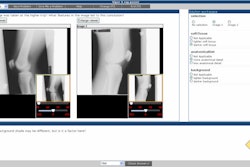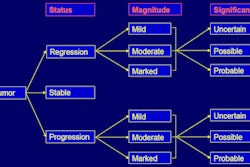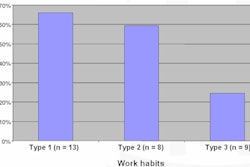

At Christchurch Polytechnic Institute of Technology (CPIT) in New Zealand, students in the Medical Imaging degree course carry out 50% of their training on campus and 50% in clinical placement. During the placement, their time is taken up with practicing "patient skills," accurate patient positioning, and applying the correct protocols to obtain a diagnostic image. What they're not able to do is experiment with a range of positions and protocols and investigate the results of various combinations.
To address this shortfall, a team at CPIT instigated the VIPER (Visual Interactive Practice Environment Resource) project, a research effort involving a consortium of New Zealand organizations. VIPER is an intelligent tutoring system that provides medical imaging students with the opportunity to test their knowledge and skills against an intelligent online tool that gives them detailed feedback as they attempt to solve problems.
Formal feedback
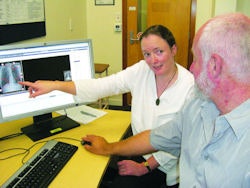 |
| Tracy Kirkbride, Ph.D., demonstrates the VIPER tool to student Michael Tait. The intelligent tutoring system has been designed to give students more self-directed learning opportunities. |
For example, if an incorrect response is given, the feedback provided could include further questions to help guide the student to the right answer. For a correct answer, a reinforcement statement is presented underlying why that response was correct. Without such reinforcement, a student could just guess the correct answers and never actually understand why they were right or wrong.
"We don't all learn by just reading text," said Michael Tait, a third-year Bachelor of Medical Imaging student. "It's great to have a learning tool which enables us, as students, to view images, experiment with settings, and get feedback on the results."
In addition, students can choose whether to receive detailed feedback or just an indication of how they have done. They can ask for a "Quick Check," "Hint," "Detailed Hint," or "All Errors" to be displayed. This flexibility provides no extra work for the course tutor, as all they need to supply is the relevant feedback and reinforcement statement (if required), then VIPER determines what the student sees.
All of the questions and the current set of feedback responses in VIPER have been created by tutors within the Medical Imaging program at CPIT. It's also possible for VIPER to run without the tutor supplying feedback, using the basic generic feedback that's programmed into the software (see figure below), but we feel that this is not as advantageous to the students.
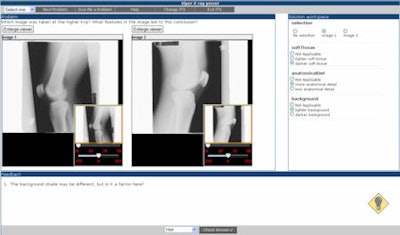 |
| Click here to enlarge this image. |
| The VIPER platform also includes some basic generic feedback programmed into the software. |
The problems are arranged into a series of five domains, which require students to perform distinct tasks. In one domain, students are required to identify features of an image, while in another, they are asked to label parts of a diagram. These images or diagrams can be anything from floor plans to electrical diagrams to chest x-rays. Another type of problem involves using experimenting with settings to answer the question, which allows students to compare images resulting from different exposures and positioning, and also enables them to critique images.
Some of these domains also offer various levels of difficulty. Within the labeling domain, for example, students are given multiple choice answers to choose from in the first level. We also hope to develop a second level where the students have to type in the correct answer without any clues, and a third level in which their response is timed. This setup allows the facility to both challenge stronger students and provide the necessary practice for those who need it more.
Teacher's choice
VIPER was designed to offer various beneficial features to the tutors themselves. For example, the system records students' responses and builds up a record of how they are performing across all the domains and tasks. This enables tutors to identify areas in which students may require additional coaching and instruction. VIPER is currently accessed through the Internet, enabling students to work on the system from home.
The tool also offers the ability to load images from many sources, including medical databases, and then attach these images to generic problems. This feature is valuable when setting up problems that involve critiquing or labeling images, as the tutor only has to enter the feedback once and it can be used several times for a range of images. Thus after the initial setup, VIPER makes it easier for tutors to provide many different problems for their students.
The first students to use VIPER have been enthusiastic about the self-learning tool, although some improvements are required, including further development on some of the domains. VIPER is, however, already being trialed at three medical imaging institutions within New Zealand and it's hoped that the current platform design will be finalized by the end of January 2009. At that point, we will look at applying the platform to other disciplines: architecture, engineering, computing and veterinary science, for example, as well as other areas of healthcare. Ultimately, we hope to make VIPER available to institutions worldwide.
The institutions involved in the VIPER research project are Christchurch Polytechnic Institute of Technology, University of Canterbury, Christchurch Medical School, University of Otago, Auckland University, Massey University, Colour Imaging Technologies, Universal College of Learning, and Unitec.
By Tracy Kirkbride, Ph.D.
Medicalphysicsweb contributing writer
January 16, 2009
Tracy Kirkbride has a Ph.D. in physics from the University of Leeds in the U.K. and has recently qualified in adult education. She is currently head of the Medical Imaging program at Christchurch Polytechnic Institute of Technology in New Zealand.
© IOP Publishing Limited. Republished with permission from medicalphysicsweb, a community Web site covering fundamental research and emerging technologies in medical imaging and radiation therapy.





